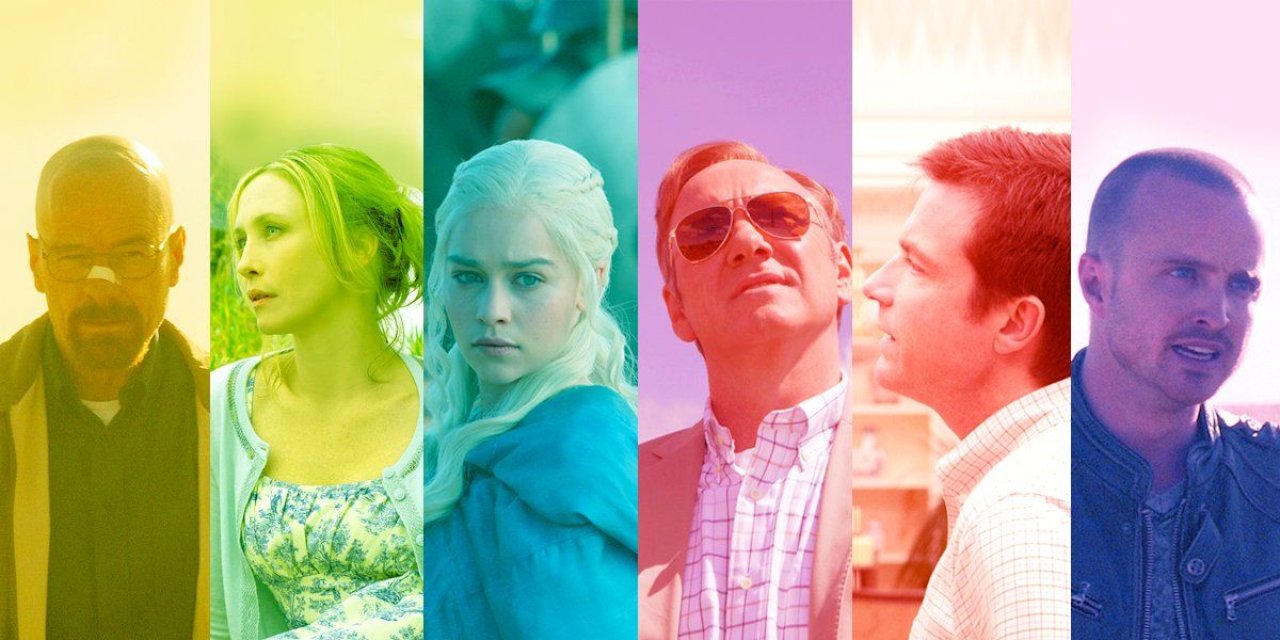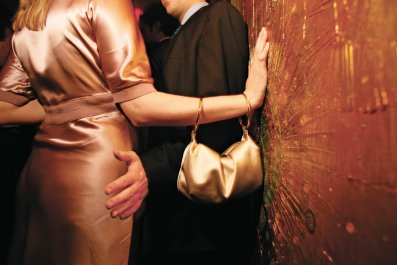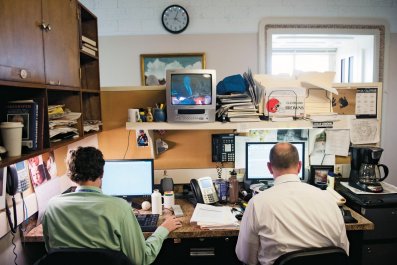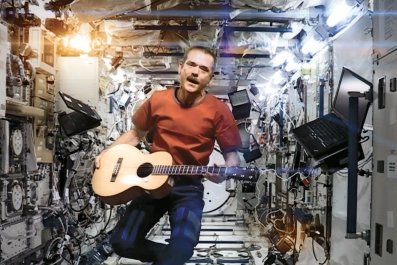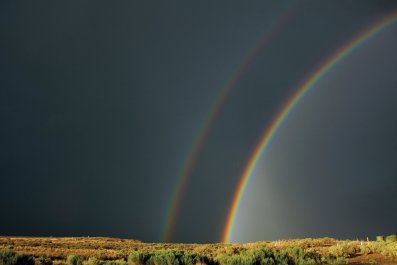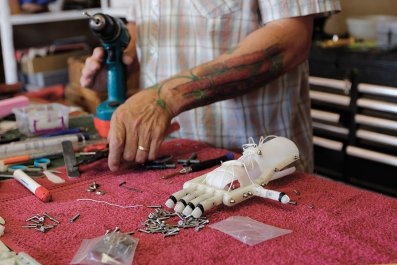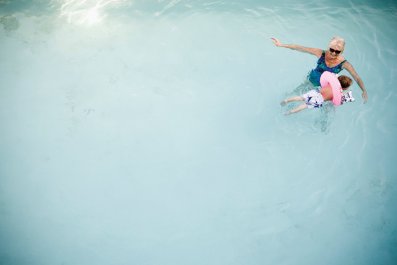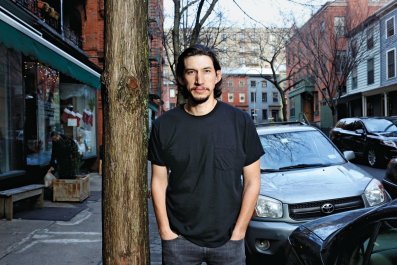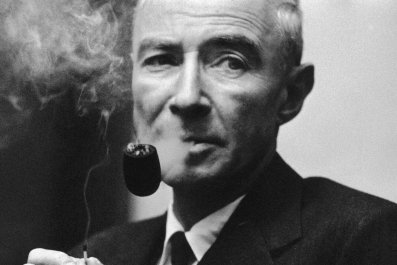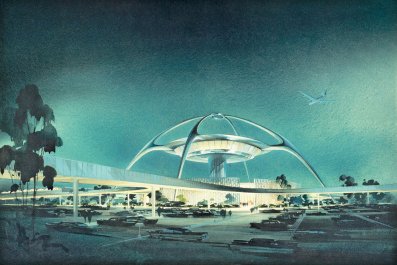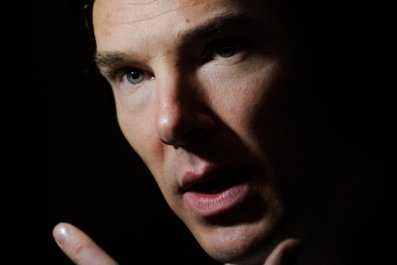The Revolution is being televised.
Anyone who enjoys even the most casual relationship with a television set is probably aware that How We Watch TV has been changing in recent years. "Binge watching," as scores of breathless critics have christened it, is increasingly common, especially among younger viewers who'd rather screen their favorite shows online, on demand, or on DVR than wait around for them to air once a week on old-fashioned TV. First you fall for a show, and then you watch it endlessly. Because you can.
But that's only half of the equation. Take a look at today's best, most buzzed-about series. The ones that receive the highest ratings from critics. The ones you talk about at work. The ones that seem likeliest to define this particular moment in television history, ages and ages hence:
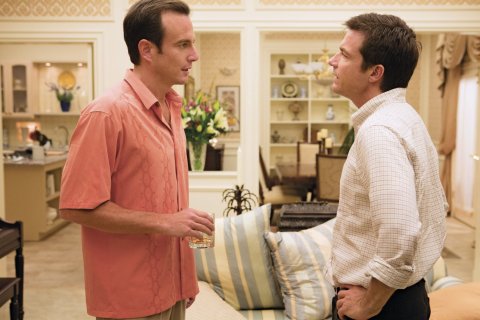
Game of Thrones, which is in the midst of its swashbuckling third season on HBO.
Breaking Bad, which is set to return for its final, brutal run of episodes on August 11.
True Blood. The Walking Dead. Homeland. House of Cards. Scandal. The Americans.
And then there are the shows we've yet to see, like Believe, the hotly anticipated new NBC series from Star Trek director J.J. Abrams about a telekinetic orphan, which was previewed for the first time during this week's network upfronts in New York City. The HBO pipeline is packed with rip-roaring narratives as well: an adaptation of Stephen King's fantasy opus, The Dark Tower; a series about two detectives on the hunt for a serial killer in Louisiana (True Detective); and the story of a group of magicians and con men attempting to bring down Adolf Hitler during World War II (Hobgoblin).
We're not only bingeing on shows like these—an adrenalinized meth saga, a pulpy vampire romp, a paranoid terrorism drama, a seedy political thriller—because we can. There's more to it than that. Talk to the people behind Breaking Bad, Game of Thrones, and so on, and it soon becomes clear that they've designed these shows to be more bingeable—more propulsive and page-turning—than anything the networks ever pushed on us in the past. How We Watch may be changing. But it's changing What We Watch as well.
Bingeing, it turns out, is how our brains want to watch television.
"I've always said that I don't see my show as serialized so much as hyperserialized," explains Vince Gilligan, creator of AMC's Breaking Bad. "That is something that, honestly, I wouldn't have been allowed to do 10 or 15 years ago."
We're living, it seems, in a new age of television: the Age of the Hyperserial. "Serialized storytelling looms larger than it did in 2003," says D.B. Weiss, one of the head writers on Game of Thrones. "If you look at the Emmy nominees of 2003—The Sopranos, Six Feet Under, The West Wing, CSI, and 24—only 24 really qualifies as strictly serial in nature. Whereas Game of Thrones, Breaking Bad, Homeland—they all qualify. As bingeing becomes possible and commonplace, it's only natural that shows should start to take it into account."
The bottom line is that binge watching is more than just a business story—more than just a story about new technologies and new modes of distribution. It's really a story about the science of storytelling itself. Bingeing, it turns out, is how our brains want to watch television. And the best storytellers on TV are beginning to figure this out.

For most of television history, network executives were allergic to serialized shows. Sequential, weekly series didn't "strip," or work, when shown out of order, so they tended to tank in syndication. Which means they didn't make any money. "When I started doing TV almost 20 years ago, studies showed that a so-called fan of a TV show probably saw one in four episodes on average," Gilligan recalls. "So of course you can imagine: with a serial like Breaking Bad, someone watching one episode out of four would be pretty lost as far as what the hell is going on." That's why the vast majority of 20th-century television was episodic: comedies like Cheers, dramas like Law & Order. Shows that could air one installment at a time, in no particular sequence, without losing viewers.
In the late 1990s, HBO upended that conventional wisdom, producing one stunning serialized drama after another: Oz, The Sopranos, Six Feet Under, The Wire, Deadwood. Then came FX (The Shield, Rescue Me) and AMC (Mad Men, Breaking Bad). Pretty soon, everyone was in agreement: a new Golden Age of Television was upon us. "The ambition and achievement of these shows went beyond the simple notion of 'television getting good,'" Brett Martin writes in Difficult Men, his forthcoming book about the cable revolution of the early aughts. "The open-ended, twelve- or thirteen-episode serialized drama ... had become the signature American art form of the first decade of the twenty-first century."
Except that the first decade of the 21st century ended more than three years ago—and how we watch television has changed drastically since then. We may have been fans. But we weren't addicts.
Today's Hyperserials resemble their Golden Age predecessors in some ways: the adult themes, the infatuation with antiheroes, the cinematic art direction. But the Golden Age shows were concerned, above all else, with the intersections of character and society; plot twists always came second. That's why, in retrospect, it's very hard to recall what actually "happened" from season to season. Mostly we remember the characters—Deadwood's swaggering Al Swearengen, The Wire's charismatic Omar Little—that it all happened to. As a result, the key dramas of the Golden Age often didn't grip viewers until the third or fourth episode; it took a while to get to know and care about their protagonists.
The Hyperserials are less patient. The suspenseful opening scene of Game of Thrones unfolds in an ominous wintry netherland and features a vanishing cluster of undead bodies, a horde of shadowy stalkers, and a deadpan decapitation. I couldn't wait to find out more about the mysterious new world I'd entered. The opening scene of The Wire, meanwhile, consists of a white cop having a slangy, somewhat inscrutable conversation with a black Baltimorean about a dead thief named Snot Boogie. It's more about introducing the show's central themes—the dysfunction of Baltimore, the humanity of both cops and criminals—than keeping you glued to your set.
And that's ultimately the biggest difference between the Hyperserials and the legendary shows that spawned them: a purer, more intense focus on one linear, series-long plotline. Hyperserials tend to do away with recaps, teasers, and exposition of any kind. They make even less sense when viewed out of order. And they always pose a clear question designed to propel the story forward. Who will rule the Seven Kingdoms? (Game of Thrones.) Will Walter White live or die? (Breaking Bad.) Will Carrie catch Brody? (Homeland.) It's not that Hyperserials don't delve into the complexities of character. They do. It's just that, unlike their predecessors, they place equal emphasis on What Happens Next.
(There are exceptions to the Hyperserial rule, of course—chief among them Mad Men, which was conceived in 2000 by Matthew Weiner, a future Sopranos alumnus. Its plotlines are almost entirely beside the point. But otherwise, the vast majority of newer shows by graduates of the Golden Age—David Milch's John From Cincinnati and Luck; David Simon's Treme—haven't quite connected with today's audience. Things, in short, have changed.)
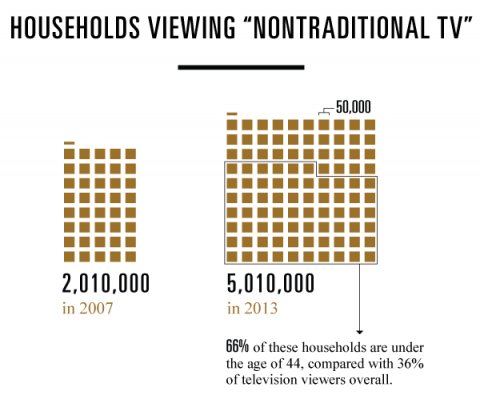
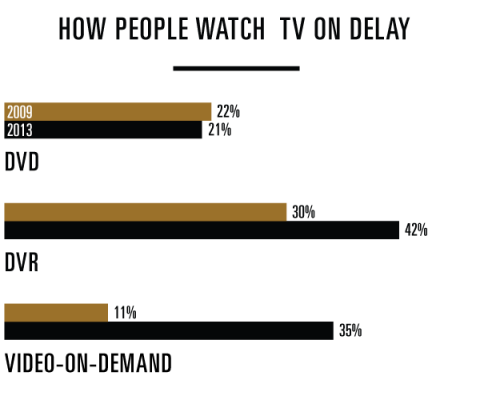
Hyperserialization is on the rise in part because it can be; when every previous episode of a particular show is instantly available, the showrunner—the industry's term for the person, usually a writer-creator type, who oversees day-to-day production of a show—is free to tell a less self-explanatory story. But the flip side of being able to watch what you want, when you want, is that you can just as easily choose to watch something else. "In Fargo, Virginia, where I was growing up, we could get NBC, ABC, CBS, and sometimes the PBS station, and that was it," says Gilligan. "Now, with the amount of story and software vying for our attention, it's amazing that anything breaks through. And so there's a lot of fear among the networks and the studios: 'How do we maintain our market share? How do we keep eyeballs on our screens?' "
The answer, it seems, is to evolve. The pioneers of television's Golden Age proved that it was possible to tell deep, complex, adult stories about antiheroic characters on the small screen. Now their successors are molding those sorts of stories into ever-more addictive morsels of pure narrative.
"It's like the people who make potato chips," says Carlton Cuse, one of Lost's head writers. "They know how to put the right chemicals in there to make you want to eat the next potato chip. Our goal is to make you want to watch that next episode."
On average, Americans watch more than five hours of television a day.
IN A certain sense, all television is addictive. This should be pretty obvious, given that Americans watch more than five hours a day, on average. At that rate, a person who lives to the age of 80 will spend 21 percent of his or her adult life—the equivalent of 4,175 days, or nearly 13 years—in front of the tube.
But what's happening to me when I binge watch? What's compelling me to click "play" on yet another episode? Putting chemicals into my potato chips is one thing. But what kind of reactions are those chemicals sparking in my brain?
I need to know because I know how it feels. Before we go any further, I have a confession to make. My name is Andrew, and I am a Lost-aholic.
My addiction started out simply enough: like most other addictions, really, someone else was doing it. It was April 2010, and my wife had just returned to her childhood home in Los Angeles for a wedding. After six serpentine seasons, Lost—the hourlong ABC drama about a dozen or so strangers who survive a plane crash only to find themselves stranded on a very peculiar island—was scheduled to come to an end a few weeks later, on May 23. In anticipation of the finale, my wife's twin sister had resolved to catch up by streaming the previous five seasons of the show on Netflix. She seemed to be enjoying herself, so before long, my wife decided to try a little Lost, too. How dangerous could it be?
When my better half arrived back in Brooklyn, where we live, she was already hooked. At first, I resisted; I'd sampled the first few minutes of the pilot back in 2005, and it didn't seem to agree with me. But resistance, as they say on TV, was futile. Within days, we were watching two or three episodes a night. As the island's mysteries and mythology deepened—the hatch, the smoke monster, the Others, the Dharma Initiative—our viewing sessions grew longer. We stopped cooking or going out to dinner. We paid the delivery guy quickly, our eyes still on the screen. At one point, I think we churned through seven episodes in a single evening. I'm pretty sure—apologies, Newsweek—that I Netflixed an episode or two at work.
And then, sometime in the second season, our addiction spiraled out of control. We were so desperate to find out What Happened Next that we made an agreement: each of us was allowed to barrel ahead even if, for some unfathomable reason, the other had a conflicting engagement, like eating in a restaurant or seeing another human being. We would just verbally recap the missing episodes the following evening, then reenter the Netflix vortex together. By the time the two-hour series finale aired on ABC, we were fully up to speed. Between us, we had watched 120 episodes of Lost in about 30 days.

According to scientists, the reason an otherwise reasonable person like me can wind up devoting so much time to TV is simple: it feels good. For starters, every on-screen movement—every gesture, cut, edit, zoom, or pan—activates our "orienting response," an evolutionary reaction to new stimuli that is designed to protect us from predators. So when I'm watching an episode of Game of Thrones, and Jaime "the Kingslayer" Lannister suddenly swings his broadsword at Brienne of Tarth, my mind and body react in unison, as if they've just registered the first flicker of a potential threat. The former focuses its attention on gathering more information; the latter goes quiet. The blood vessels to my brain dilate. Their muscular counterparts constrict. And my heart slows its beating. As media studies professor Robert Kubey and psychologist Mihaly Csikszentmihalyi wrote in 2002, "The orienting response may partly explain common viewer remarks such as 'If a television is on, I just can't keep my eyes off it,' … and 'I feel hypnotized when I watch television.'"
Hypnosis isn't a bad metaphor. After watching Game of Thrones for a mere 30 seconds, my brain begins to produce the alpha waves typically associated with hazy, receptive states of consciousness, which are also generated during the "light hypnotic" stage of suggestion therapy. At the same time, my neurological activity switches from the left hemisphere to the right—that is, from the seat of logical thought to the seat of emotion. Whenever this shift takes place, my body is flooded with the natural opiates known as endorphins, which explains why viewers have repeatedly told scientists that they feel relaxed as soon as they switch on the television, and also why this same sense of relaxation tends to dissolve immediately after the set is turned off.
The pattern mimics addictive drug use, as my wife and I know too well. After two hours of Game of Thrones, the apartment goes suddenly quiet. Our guilty eyes meet from opposite ends of the sofa. We are thinking the same thing. Maybe just one more? Kubey and Csikszentmihalyi describe it as a kind of withdrawal response. "Habit-forming drugs work in similar ways," they wrote. "A tranquilizer that leaves the body rapidly is much more likely to cause dependence than one that leaves the body slowly, precisely because the user is more aware that the drug's effects are wearing off. Similarly, viewers' vague learned sense that they will feel less relaxed if they stop viewing may be a significant factor in not turning the set off. Viewing begets more viewing."
This last bit helps to explain the underlying appeal of serialized shows and the recent rise of binge watching. Before DVDs, Internet streaming, and video-on-demand, fans of television had two (rather unsavory) choices: (1) watch whatever program happened to be on, however idiotic it was, or (2) experience immediate endorphin withdrawal. Now we have a third: watch the shows we like for as long as we like. Serialized, streaming TV is tailor-made to keep the endorphins flowing.
So far, no scientist has studied binge watching per se, or the Hyperserial generation of television programming that has inspired so much of it. But the groundbreaking work of a Princeton University psychologist named Uri Hasson may hint at why the current trend toward narrative precision may also be triggering an increase in viewer engagement.
Hasson, a bald, bespectacled professor with a thick Israeli accent, doesn't binge watch any television shows himself. "That is for people without work the next morning—or children," he quips. But Hasson may understand better than anyone else why the rest of us can't help ourselves. In 2008 he coined the term "neurocinematics"—the neurobiological study of how films interact with the brain—to describe his work. A study published that year in Projections (subtitle: The Journal for Movies and Mind) was particularly revelatory. Employing fMRI technology, Hasson and his neuroscience colleagues screened four film clips—from Sergio Leone's The Good, the Bad and the Ugly, Alfred Hitchcock's "Bang! You're Dead," Larry David's Curb Your Enthusiasm, and an unedited, single-camera shot of New York's Washington Square Park—and then watched as viewers' brains reacted. Their goal? To measure the degree to which different people would respond the same way to what they were seeing.
The audience has so many choices and so many places to go that they won't wait.
The results varied widely, depending on which film was shown. The unstructured, "realistic" video from Washington Square Park, for instance, elicited the same neurological reaction in only about 5 percent of viewers. Responses to Curb Your Enthusiasm were slightly more correlated, at roughly 18 percent; and The Good, the Bad and the Ugly ranked even higher, 45 percent. But ultimately, Hitchcock was the runaway "favorite": a full 65 percent of the study's cerebral cortices lit up the same way in response to the clip from "Bang! You're Dead."
Hasson's conclusion was fascinating: the more "controlling" the director—the more structured the film—the more attentive the audience. "In real life, you're watching in the park, a concert on Sunday morning," Hasson tells me. "But in a movie, a director is controlling where you are looking. Hitchcock is the master of this. He will control everything: what you think, what you expect, where you are looking, what you are feeling. And you can see this in the brain. For the director who is controlling nothing, the level of variability is very clear because each person is looking at something different. For Hitchcock, the opposite is true: viewers tend to be all tuned in together."
Is it possible, then, that the recent trend toward more structured, page-turning narratives on television might be generating ever-higher levels of cerebral correlation—and viewer engagement—in living rooms across the country?
"Absolutely," Hasson says.
SHOWRUNNERS AREN'T scientists, of course. They rely on instinct, not fMRI devices, to decide which chemicals to cook into our narrative potato chips. But where do their instincts guide them? And which chemicals are they relying on these days? To find out, I tracked down the man who was to blame for my first big bout of binge watching: Carlton Cuse of Lost.
Cuse, a tall, bassoon-voiced TV veteran who once rowed crew at Harvard and looks like a cross between Anthony Bourdain and Nick Nolte, is in Los Angeles finishing a pilot for NBC. When I finally get him on the phone, I immediately tell him about my battle with Lost addiction. He does not seem shocked. At all. "I believe that with Lost we were on the front edge of a trend," Cuse tells me. "The audience has so many choices and so many places to go that they won't wait. So as a storyteller you can't hold back. You have to spend your bullets quicker and sooner. The event that used to be the series finale better happen by episode six now, or your show might be dead."
Lost was a weekly master class in narrative invention, and Cuse points to one particularly surprising—and effective—plot twist to illustrate how he and his fellow showrunner, Damon Lindelof, did it. Over more than 70 episodes, Cuse and Lindelof conditioned the audience to construe any scene taking place off the island as a flashback to the survivors' previous lives. The Season 3 finale was full of such scenes. But then, at the end of the episode, Cuse and Lindelof revealed that all of the finale's off-island interludes were actually flash-forwards instead—previews of the characters' lives after escaping the island.
Discussing it now, Cuse still sounds giddy. "The moment was just this beautiful gift-wrapped piece of narrative that we knew that we were going to drop on the audience in the best way possible—when they were the most unsuspecting," he says. "It was like having a Christmas present sitting up on a shelf, and you have months to think about how exciting it's going to be when you give it to your wife, you know?" The maneuver was pure Hyperserial genius. As soon as I realized that I'd just caught a glimpse of where each character was destined to end up, I couldn't wait to find out how they'd get there.
The flip side of providing enough story to hook viewers early on, however, is that you also have to withhold enough story to keep them wanting more. Episodic television followed a simple formula: the false leads on a police show, the near-death on a hospital drama, all heading toward one or two possible outcomes at the end of the hour. But the series-long narrative arcs of today's Hyperserials require a delicate balance of structure and surprise to remain both believable and gripping over multiple seasons.

So while Breaking Bad's Vince Gilligan admits to feeling the same "spend your bullets" pressure as Cuse, he also warns against "throwing too much at the viewer too quickly" and not allowing "the good stuff we started with to percolate and trickle down and settle in."
"As many distractions as we have nowadays, we still want to curl up in front of a fireplace with a good book," he tells me during a break from editing his final batch of episodes. "We still want to be told a story, all of us, by someone who clearly knows what they're doing and knows how to pace it out. Not too slowly but not too quickly."
This is why structure is critical. Breaking Bad's Season 2 premiere, for example, opens with a slow-motion shot of a charred, cyclopic pink teddy bear sinking to the bottom of a pool. "We wanted to start with what would be the final image of that season, and we had this image that sort of came out of nowhere," Gilligan recalls. "So then we thought, OK, what explains this burned-up teddy bear? ... Was there a meth-lab explosion? Was there a home invasion? What happened?"
The ominous pink teddy bear reappears throughout the season—but the disaster that explains it doesn't actually occur until the season finale. As a result, viewers spend 13 episodes asking themselves the same question that Gilligan and his team were struggling to answer in the writer's room: what the heck happened to that teddy bear? And there's only one way to find out.
BOTH LOST and Breaking Bad were deviously addictive series. But while they jibed with—and ultimately benefited from—our new wherever-whenever viewing patterns, they weren't actually designed to take full advantage of them.
The shows of the future will be. In March 2011, Netflix announced that it was getting into the content business itself, beginning with an American adaptation of the British political drama House of Cards—with a reported $100 million budget. All that money eventually showed up on screen: the sleek sets, the ominous score, the A-list cast, the jaundiced, atmospheric cinematography. But the most innovative aspect of the deal that Netflix Chief Content Officer Ted Sarandos struck with the House of Cards creators was ultimately less obvious: he promised them that the company would commit to two seasons right off the bat. No development deal; no pilot tests. Twenty-six full hours to work with.
That commitment allowed the show's story to be told—and, later, absorbed by the audience—in a way that circumvented the tired conventions of network television. The result was an even more habit-forming Hyperserial. At one point, Sarandos commissioned an internal study that found that by the season finale of a standard hourlong network drama "as much as 20 percent of the episode" consists of "the 'Previously on ...' recap, the 'Next on ...' teaser, and references to something you already knew." By eliminating all of that exposition, he says, "the actual storytelling time on Netflix can be 20 percent longer. When you can give the filmmaker a much bigger canvas, they're going to make much better television. Because they're worried about nothing but consumer engagement."
Beau Willimon, the head writer on House of Cards, agrees. "Knowing that we had 26 hours, guaranteed, allowed for much more sophisticated, layered storytelling," he says. "You don't have to sell yourself and audition week to week. You don't even have to think of it as television. And none of us did. For us, it was a 13-hour movie."
And that's what it became for many viewers as well. At midnight on February 1, 2013, Netflix posted all 13 episodes of the show's first season—an unprecedented move that both reflected how the show was made and respected how its fans would want to watch. The critical response was almost uniformly positive. "If you think network executives are nervous," wrote USA Today's Robert Bianco, "imagine the actors who have to go up against [Kevin Spacey and co-star Robin Wright] in the Emmys." Viewers were even more enthralled. According to internal Netflix data, thousands of subscribers finished all 13 episodes in the first 14 hours after the show debuted online—the ultimate testament to its Hyperserial appeal.
Still, while House of Cards may have been the first show made for multi-episode marathons, it basically told a straightforward story. The forthcoming season of Arrested Development—the brilliant absurdist comedy canceled by Fox in 2006, resurrected by Netflix in 2012, and scheduled to return on May 26—is set to rewrite the rules of TV storytelling for the new streaming world we're living in.
On a recent Tuesday afternoon, I emailed an address I was told belonged to Arrested Development's creator, Mitch Hurwitz, requesting an interview about Netflix, his show, and the future of television. I wasn't expecting to hear back. But 24 hours later, a reply appeared in my inbox.
"I'm completely unavailable right now," Hurwitz began. "I've got something like 18 more days to finish six episodes or three hours of material. Which is two movies ... which movie guys get six to eight months to do. So—I just can't pick up a phone as I never have two uninterrupted minutes in a row."
My heart sank. I'd actually made contact with the creator of one of my favorite television shows—only to have him personally reject me because he was too busy hyperwriting and hyperproducing. But Hurwitz, it turns out, wasn't done.
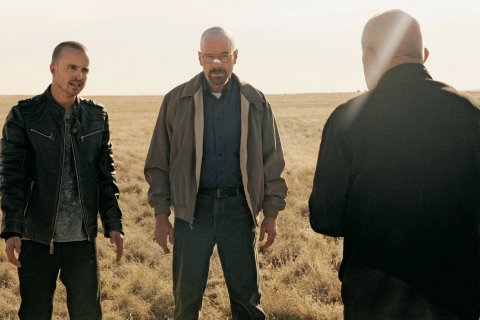
"Would it be presumptuous of me to dictate a couple of things into Siri right now that might anticipate some questions?" he asked. "Yes. Of course it would. It's kind of obnoxious. But I'm going to do it anyway! Because I sort of love this topic. It's my favorite topic, actually. How to try to find a way to innovate as the world changes."
Arrested Development isn't a drama. It's a comedy. But because its first three seasons were so dense with in-jokes, multilayered gags, and seemingly obscure references that made sense only later, in retrospect, it became something of a Hyperserial itself. To really "get it," you had to watch every episode, which is the same principle that makes Breaking Bad & Co. so habit-forming. "I was into the idea of layering jokes and hidden plot elements into the show that in many ways couldn't be enjoyed in one viewing," Hurwitz explained. "There would be no way to know, for instance, that George and Lucille Bluth had built their wobbly mini-mansions for Saddam Hussein until the end of the first season, despite all sorts of clues."
As the series progressed, Hurwitz upped the ante by writing more jokes that would morph into new jokes after viewers had seen later episodes—a maneuver that rewarded repeat viewings. He now believes that's why Arrested Development became such a cult classic. "It is safe to say that some of that complexity might have kept Arrested Development from initially being more popular," Hurwitz wrote. "But as it turned out it was the new technologies that made the show popular after its time"—far more people have watched Arrested Development on Netflix than ever saw it on Fox —"and I do like to think that had I not chosen to sort of embrace a type of storytelling that depended on new technology, the show wouldn't have caught on."
For the new season, Hurwitz is attempting to do it again, describing "what has emerged" as "a combination anthology, crossword puzzle, and someday hopefully a 'choose your adventure' version of the show." We'll have to wait until May 26 to fully absorb the new format, but here's what Hurwitz is willing to say now: He's given each individual character "a storyline that we follow separately in an episode dedicated to, and from the point of view of, that character." That's 15 characters, 15 episodes—ideal for wherever-whenever viewing. But because the streaming format allows viewers to binge as well, "a larger story" begins to take shape "when all the episodes are consumed together."
Hurwitz compared the experience with reading a novel—or perhaps a collection of interrelated short stories. "Like that, it only works if an audience has control over what they want to see, review, skim, at their own pace," he told me. "The idea is to give ownership of that experience to the audience entirely. I've tried to make sure that for those who are interested in reading it like a beach book, without giving it their full attention, that will be satisfying, and for those who want to delve in deeper and revisit hidden connections or cause-and-effect elements in the storytelling, they'll have the freedom and the ease of doing so."
The short-story format, Hurwitz added, doesn't just mirror the way we watch now—it anticipates the way we may watch in the future, when viewers could potentially "jump from moment to moment, leaving one character for the intersecting character and staying with them for their story," or even watch the entire season "chronologically instead of by character."
Hurwitz isn't the only showrunner preparing for the next big thing in television. In fact, almost everyone I contacted for this story seemed to have one eye on today's version of TV and one eye on tomorrow's. Carlton Cuse brought up the rumors that Apple will soon release a television with second-screen technology—an innovation that would provide an instant platform for "pieces of the story that we are never going to tell on the mothership show." Uri Hasson predicted that his fMRI machines may eventually be used to re-edit episodes by measuring "the level of control, minute by minute, on different dimensions: the visual aspect, the emotional aspect, the dialogue aspect." David Benioff, showrunner for Game of Thrones, wondered if someday we'd "merge television viewing and videogame playing, so you're taking control of a certain character and making decisions for her."
For Hurwitz, the impulse to innovate is a natural part of the storytelling process. "Truthfully, I'm just doing what anyone does in any field when new technology comes along," he explained. "When glass was introduced architects immediately started designing windows into homes. But it wasn't until, what, the New York Apple store, that whole buildings were designed out of glass because of the advances in technology.
"So some of what I'm going for might be folly in the sense that I might be trying to build a house out of glass a little early. But Netflix has had some success building a house out of cards, so why not try?"
"I'm mixing metaphors faster now than the Bluths can mix drinks," he added. "So I'll shut up."


